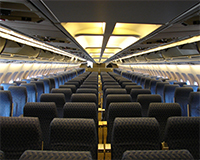
The airline industry comprises of businesses that provide flight, transport, customer service, maintenance, safety and overall operations of an aircraft carrier / management company. Transportation is included although not limited to just passengers. In many instances you can expect to see cargo or freight also included with an airlines transport services. In simple terms, an airlines main function is to assist with transporting passengers and their baggage from one destination to another.
There are different sizes, styles and configurations of airlines that you will observe (1). Each country may have differences to a degree. Although in general, there are three different types of airlines that you will encounter, or have already seen in operation. These different types include:
Regional
Regional airlines typically serve particular regions of a certain country. They are one of the smallest of the three types and usually provide services in niches that major and national airlines usually don’t provide. Regional airlines usually mostly deal with the transport of passengers and not so much cargo over long distances.
*In some situations regional airlines can be broken down even further (large, medium & small) based on factors such as passenger count, category of aircraft and revenue; large, medium & small.
National
National airlines are a step up from regional. A national airline will still provide regional service, however it also provides access to a selection of long distance and international routes / destinations as well. In most cases, a national airline will employ more staff than a regional airline would require. Overall, their type of aircraft and fleet size will also be much different when compared to a regional.
International (Major)
The largest out of the three types of airlines that you’re going to encounter is the international or major airline (2). Major international airlines typically generate more than 1 billion in annual revenue. International airlines also usually employ more staff than national and regional airlines. They also usually transport more than just passengers. Transportation of cargo and freight over long distances is also expected.
Airline Business Models
The airline industry can differ slightly from region to region internationally. It is argued that there could be more, although it is normally expected that you will encounter these three business models when it comes to operating an airline.
Full Service Carrier (Legacy)
 One of the easiest way to describe a full service carrier would be to reference one of the major carriers that operate out of your country. These carriers usually provide passengers with inflight meals and entertainment, blankets, pillows, checked baggage etc. These amenities are also included in your ticket price.
One of the easiest way to describe a full service carrier would be to reference one of the major carriers that operate out of your country. These carriers usually provide passengers with inflight meals and entertainment, blankets, pillows, checked baggage etc. These amenities are also included in your ticket price.
Flight options such as first class, business class, economy etc. are what you can expect to see while working with a full service carrier. Since most full service carriers are also international or major airlines. They will normally transport passengers as well as cargo.
Examples of full service carriers include:
- Air Canada
- American Airlines
- Lufthansa
- Air France etc.
Low Cost Carriers (LCC)
A low-cost carrier is an airline that is classified as not offering the traditional services or amenities that you may find at a full service carrier. As a result, lowering the cost of your airfare and seat price. Services that you may find to be absent from some low-cost carriers include in-flight meals and entertainment, pillows, blankets etc. Availability of these services does vary between different low-cost carriers depending on their budget (3).
Another difference from full service carriers is the selection of aircraft used. A low-cost carrier may not need as many aircraft or as many large aircraft to operate effectively within their market.
Examples of low-cost carriers include:
- Southwest Airlines
- JetBLue
- Ryanair
- WestJet etc.
*Low-cost carriers are generally seen as prime competition to full service carriers when it comes to price.
Holiday Carriers (Charters)
These carriers usually provide holiday travel through contracts signed with travel agencies to tourists. Group travel is usually encouraged as opposed to individual ticketing. In these situations the travel agency is usually the one responsible for filling seats in the aircraft.
When dealing with a charter carrier. You can almost expect service to be somewhere in between what is offered from the carriers above.
Cargo Carriers (Freight)
As the name suggests, cargo carriers typically only deal with the transportation of cargo and freight. Despite being their primary services, they do still offer passenger transport in some divisions or subsidiaries of airlines.
In Conclusion
With the different options available when it comes to choosing an airline. There are almost just as many different business models to choose from when it comes to operating.
Getting involved in the airline business can be a very challenging task for almost any CEO or business owner. If you or anyone you know is looking for more information, feel free to read our guide. This will briefly explain what you can expect when deciding to plan and organize, what is needed to commence the process of starting your own airline.
References:
1. Kevin Bonsor, How Airlines Work, retrieved from: https://science.howstuffworks.com/transport/flight/modern/airline1.htm
2. AeroGuard Flight Training Center, The Difference Between Major and Regional Airlines, retrieved from: https://www.flyaeroguard.com/blog/regional-airlines
3. ICAO, Low Cost Carriers (LCCs), retrieved from: https://www.icao.int/sustainability/Pages/Low-Cost-Carriers.aspx